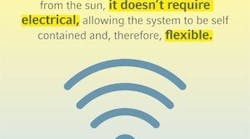The need for Internet connection and wireless communications is ever-increasing, but expanding wireless Internet access to outdoor areas with limited access to electrical grids can be difficult. Up-and-coming solar-powered WiFi technology, however, offers a solution that can be used almost anywhere.
“When you deploy wireless access points, they must hook up to some sort of tower,” says Fred Marks, owner and president at Miracle Strip Wireless Inc. in Destin, FL. “You can either run it into a 110-volt outlet, or you can run Power over Ethernet on a cable. Solar WiFi is a different animal; you can install this device just about anywhere, but the power comes directly from the sun.”
Because solar WiFi receives its energy from the sun, it doesn’t require electrical, allowing the system to be self contained and, therefore, flexible. According to Sanjit Biswas, CEO and cofounder at San Francisco-based Meraki, the “development of solar WiFi was driven by a desire to minimize effort for installation and operation of wireless networks, and make wireless more attainable and affordable in areas where extending electrical power can be expensive and time consuming.”
The easy installation means that solar WiFi can be installed in a number of applications, including parks, residential complexes, and hotels. “The only disadvantage is that it must be deployed outdoors to receive the sun’s energy,” says Biswas. “A solar-powered wireless network providing coverage indoors would require additional devices.”
Solar WiFi is a relatively simple system – it consists of a solar panel installed on a pole and a solar-charged battery system that operates a specially designed, low-power-consumption wireless radio. A single pole or access point can get up to 1,000 feet of coverage. And, aside from the alternative power source, solar WiFi provides the same quality wireless Internet services as traditional WiFi.
The green aspect of solar-powered WiFi is also of interest to potential users, although Biswas says, “the most significant cost-saving, green benefits come from not needing to install and run power cabling. Installing power cables could add 20 to 30 percent to the overall deployment cost.” Sometimes, running cables isn’t an option in certain locations; however, the cost of the solar equipment can become pricey. “You definitely pay a premium,” says Marks, who notes that there can sometimes be a $600 price difference between solar and traditional WiFi equipment. But, solar WiFi panels have the added benefit of easy maintenance. “The only special requirement is access to the sun,” says Biswas. Marks says that the panels stay clean from rainfall and are resistant to weather, such as lightning and salt air from the ocean. “The only maintenance is keeping the birds off,” says Marks.
Solar WiFi isn’t yet widely used in the United States; according to Biswas, though, “the concept is growing in popularity, and we expect that to continue for some time.” Marks is also confident in increased use of solar WiFi in the future: “I think you’re going to see solar take off,” says Marks.
Amanda B. Piell ([email protected]) is news editor at Buildings magazine.


